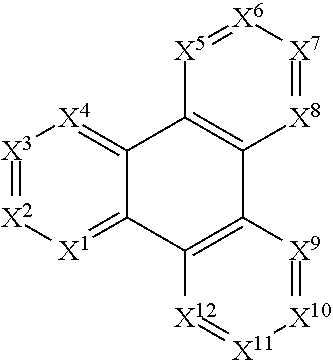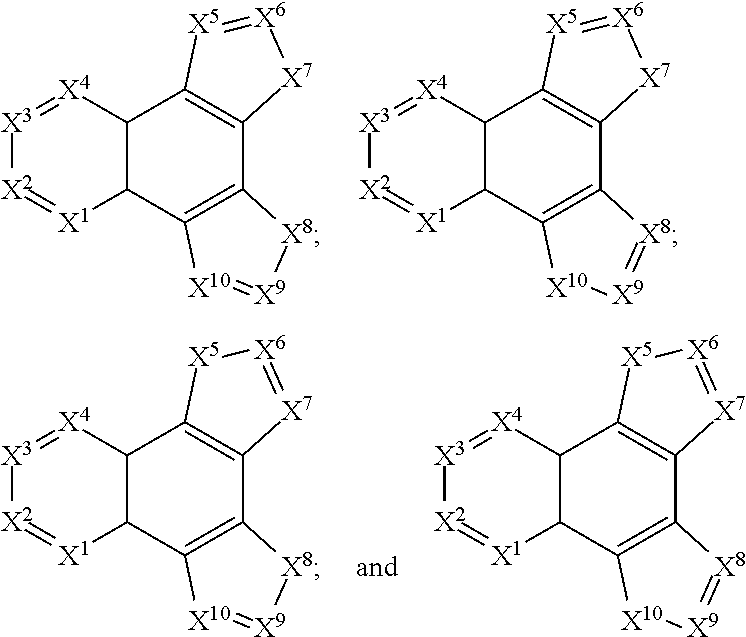Host materials and ligands for dopants in organic light emitting diodes
a technology of organic light-emitting diodes and host materials, which is applied in the field of organic electronics, can solve the problems of low success rate, long time lines, and high cos
- Summary
- Abstract
- Description
- Claims
- Application Information
AI Technical Summary
Benefits of technology
Problems solved by technology
Method used
Image
Examples
example 1
Experimental Section
Introduction
[0181]Due to synthetic accessibility, most reported H2P derivatives are based on 1,10-[f]phenanthroline. There is no report of H2Ps with potential high triplet energies with different nitrogen placement other than 1,10-positions. By placing nitrogen atoms at different position on H2P, physical properties such as triplet energy, redox potential, and charge transport ability can be tuned to meet the requirements of blue PhOLED applications. For example, three H2P isomers based on imidazo[4,5-f]-1,10-phenanthroline, imidazo[4,5-f]-3,8-phenanthroline, and imidazo[4,5-f]-4,7-phenanthroline derivative were shown to possess different triplet energies ranging from 2.76-2.91 eV. Moreover, significant discrepancies in their hole-transport properties lead to more than 10 times difference in device efficiencies for the H2P-based devices. Computations based on the methods of the invention for these H2P hosts not only showed triplet energies well-matched to the exp...
example 2
Screening Methods for OLED Materials
[0192]Once a library has been identified and the molecular modeling software has been used to predict the electronic properties of each member of that library, the library needs to be searched to find the optimal compounds for the chosen application, in the present case for use as host materials in phosphorescent OLEDs. In other embodiments, the library needs to be searched to find the optimal compounds for use as host materials in OLEDs which operate by one or more of phosphorescent, fluorescent, TADF, or triplet-triplet annihilation processes. The approach described here could be used for OLEDs of any color (e.g. blue). Exemplary screening methods include sorting the library by singlet, triplet, HOMO, LUMO energies as well as dipole moment and reorganization energies for holes and electrons and set thresholds for each, based on a given dopant. With sufficiently stringent thresholds only a small number of compounds in the library will meet all of...
example 3
Screening Libraries for OPV Materials
[0205]The basic mechanism of photocurrent generation in OPVs can be illustrated with two organic materials, one a net electron donor (D) and the other an acceptor (A). The process is illustrated in FIG. 14 and can be broken down into four sequential steps. The first step is light absorption, leading to exciton formation. The exciton can be formed in either the donor or acceptor layer. The exciton then diffuses to the D / A interface, or alternatively decays to the ground state. The optimal thickness is determined by the exciton diffusion length, which is related to the ratio of the diffusion rate, kdiff; to its natural decay rate, kdecay. The typically short exciton diffusion lengths (LD) of ˜10 nm limiting the thickness of D and A layers, and thus the amount of light that can be collected and ultimately the efficiency of OPVs.
[0206]At the D / A interface, the exciton undergoes a charge transfer reaction, forming a hole and electron in the D and A la...
PUM
 Login to View More
Login to View More Abstract
Description
Claims
Application Information
 Login to View More
Login to View More - R&D
- Intellectual Property
- Life Sciences
- Materials
- Tech Scout
- Unparalleled Data Quality
- Higher Quality Content
- 60% Fewer Hallucinations
Browse by: Latest US Patents, China's latest patents, Technical Efficacy Thesaurus, Application Domain, Technology Topic, Popular Technical Reports.
© 2025 PatSnap. All rights reserved.Legal|Privacy policy|Modern Slavery Act Transparency Statement|Sitemap|About US| Contact US: help@patsnap.com



